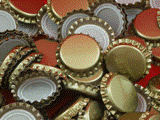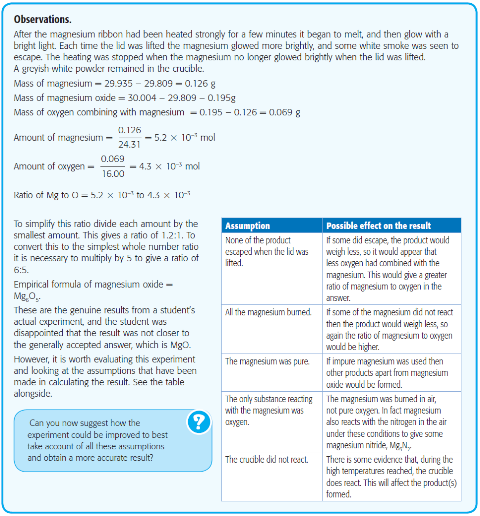Formula of magnesium oxide

 Determining the empirical formula of magnesium oxide
Determining the empirical formula of magnesium oxide
Why do the experiment?
Many students will have done this experiment before they started the Diploma programme so some teachers are surprised I include it. It is very simple (so there is no separate worksheet) but I find it worthwhile for three reasons. The first is to show that using simple materials can sometimes be better. Traditionally a porcelain crucible is used but I used to find that these often cracked in the heat and were expensive to replace. In addition it was also necessary to keep lifting the crucible lid with tongs in order to let air in. Now I use two metal beer bottle caps which cost nothing and actually do a better job! The second important reason for the experiment is that it is useful early on in the programme to train students how to evaluate an experiment. The third, and possibly the most important reason, is that it covers one the mandatory laboratory component areas, Topic 1.2. 'The obtaining and use of experimental data for deriving empirical formulas from reactions involving mass changes'.
Procedure
 Cut a 10 cm strip of magnesium ribbon. Clean it with emery paper and wind it round a pencil to make it into a coil. Weigh two empty beer bottle caps (make sure any plastic inside the caps has been removed) and then weigh them with the magnesium. Place the cap with the coil of magnesium in it on a clay triangle and then put the other cap on top. Heat strongly with a Bunsen burner until no more reaction occurs. After cooling reweigh.
Cut a 10 cm strip of magnesium ribbon. Clean it with emery paper and wind it round a pencil to make it into a coil. Weigh two empty beer bottle caps (make sure any plastic inside the caps has been removed) and then weigh them with the magnesium. Place the cap with the coil of magnesium in it on a clay triangle and then put the other cap on top. Heat strongly with a Bunsen burner until no more reaction occurs. After cooling reweigh.
Safety
The only real hazard is the danger of burns from touching the set-up while it is still very hot.
Evaluation
Students are often pleased if they do obtain MgO for the empirical formula or disappointed if they do not. Ask the students what assumptions they have made and how each might affect the result if they were not true. There are many false assumptions, perhaps the biggest is that the magnesium is combining only with the oxygen in the air whereas in reality much of the product is magnesium nitride not magnesium oxide. If you do use the beer caps then you have to assume that the paint that burns off will not affect the result but in fact the mass change due to this is insignificant and should have little or no effect. You can then ask them how the experiment could be improved to give a more accurate answer. A full explanation of this together with how the calculation should be carried out using sample results is given below and can be downloaded as a pdf file, ![]() calculation & evaluation of magnesium oxide.
calculation & evaluation of magnesium oxide.


 IB Docs (2) Team
IB Docs (2) Team